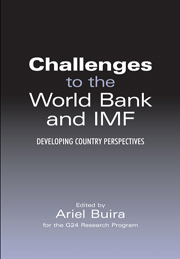Book contents
- Frontmatter
- Contents
- Contributors to this volume
- Foreword
- Introduction
- 1 The Governance of the IMF in a Global Economy
- 2 Who pays for the IMF?
- 3 An Analysis of IMF Conditionality
- 4 Achieving Long-Term Debt Sustainability in Heavily Indebted Poor Countries (HIPCs)
- 5 The Poverty Reduction Strategy Paper Approach: Good Marketing or Good Policy?
- 6 Capital Management Techniques in Developing Countries
- 7 International Reserves to Short-Term External Debt as an Indicator of External Vulnerability: The Experience of Mexico and Other Emerging Economies
- 8 Mechanisms for Dialogue and Debt-Crisis Workout that Can Strengthen Sovereign Lending to Developing Countries
- 9 Developing a Global Partnership for Development
- 10 International Financial Institutions and International Public Goods: Operational Implications for the World Bank
- Index
6 - Capital Management Techniques in Developing Countries
- Frontmatter
- Contents
- Contributors to this volume
- Foreword
- Introduction
- 1 The Governance of the IMF in a Global Economy
- 2 Who pays for the IMF?
- 3 An Analysis of IMF Conditionality
- 4 Achieving Long-Term Debt Sustainability in Heavily Indebted Poor Countries (HIPCs)
- 5 The Poverty Reduction Strategy Paper Approach: Good Marketing or Good Policy?
- 6 Capital Management Techniques in Developing Countries
- 7 International Reserves to Short-Term External Debt as an Indicator of External Vulnerability: The Experience of Mexico and Other Emerging Economies
- 8 Mechanisms for Dialogue and Debt-Crisis Workout that Can Strengthen Sovereign Lending to Developing Countries
- 9 Developing a Global Partnership for Development
- 10 International Financial Institutions and International Public Goods: Operational Implications for the World Bank
- Index
Summary
Abstract
We examine the experiences of five developing countries that employed various capital management techniques during the 1990s. By ‘capital management techniques’ we refer to policies of prudential financial regulation and controls that affect international capital flows to achieve national economic goals. One key finding is that by employing a diverse set of capital management techniques, policymakers in Chile, Colombia, Taiwan Province of China, Singapore and Malaysia were able to achieve critical macroeconomic objectives. These included the prevention of maturity and locational mismatch; attraction of favored forms of foreign investment; reduction in overall financial fragility, currency risk, and speculative pressures in the economy; insulation from the contagion effects of financial crises and enhancement of the autonomy of economic and social policy. We also examine the structural factors that contributed to these achievements and consider the costs associated with the capital management techniques employed. We conclude by considering the policy lessons of these experiences and the political prospects for other developing countries that wish to apply them.
Introduction
Developing countries can use capital management techniques to strengthen financial stability, support good macroeconomic and microeconomic policies and boost investment. Countries have, in fact, employed these techniques during the 1990s; and so we consider the experiences of five such countries.
We use the term capital management techniques (CMTs) to refer to two complementary (and often overlapping) types of financial policies: policies that govern international private capital flows, called capital controls, and those that enforce prudential management of domestic financial institutions.
- Type
- Chapter
- Information
- Challenges to the World Bank and IMFDeveloping Country Perspectives, pp. 141 - 174Publisher: Anthem PressPrint publication year: 2003
- 7
- Cited by



